Southeast Utah
After the vast scenery and staggering dimensions of Canyonlands, moving south from Moab delivered a more subdued experience — but nonetheless excellent.
We headed south along US-191, looking for our next “pause”. We explored along the Needles access road (UT-211), looking at many different camp areas. The broad, dusty Superbowl campground seemed unappealing, but just as we were about to leave, we spotted a nice site, shaded by old gnarly cottonwood trees. Out our side window was a nice view of the distant Six-Shooter Peak. Across the way, a big bluff posed for the sunset. We settled in, for what would be three windy, dusty days of hot, dry Utah weather. Pretty, though.
One of what would be many rough and rocky trails led us to the gorgeous Green River Overlook. This is near the end of a 7-mile trek right out of the Visitors’ Center.
It was REALLY windy. I chickened out just after Karin shot this picture.
There she is, ready to capture my death-plummet – – – it was too windy for me to hear her yelling at me to get back from the edge.
From this spot, it’s just possible to see the distant, alien-looking landscape, of the needle-like pinnacles that gave the area its name.
After leaving the Overlook, instead of reversing course back to the Visitors’ Center, we decided to take a faint track to the southeast. This little tiny road wound through totally empty terrain, sometimes deep in silty dust, sometimes rocky and rough as a corncob. This kind of exploring is why we carry extra food/water, a tent and sleeping bags. It’s a LONG way from anywhere, and we don’t want a simple mechanical breakdown to be life-threatening.
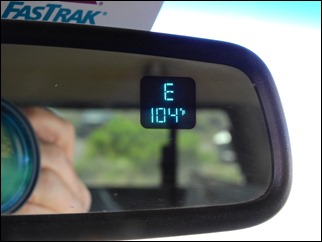 The weather was toasty…
The weather was toasty…
Fortunately, Ralph’s cooling system works well even with the A/C on full blast.
And yes, it was a dry (low humidity) day — but it was still 10F warmer than body temperature, pretty uncomfortable.
Almost all the area outside the Park is open-range cattle country. So we became accustomed to finding cattle in the roadway, anywhere and everywhere. They can be skittish, and scurry away at our approach, and they can be dumbly obstinate, needing almost to be honked or bumped to get out of our path. The youngsters also have an alarming tendency to dart in front of passing vehicles.
All along Lavender Canyon, delicately-hued outcroppings of plants attest to the name.
And of course, everywhere we went, the ubiquitous Utah sandstone presented us with its delights.
One promising “roadway” turned into a devastated series of washouts (from Spring rains). Not even an ATV track to follow through the battered terrain. It took us 20 minutes just to walk 100 yards to check it out. Had to turn back — too bad, because the original road made a lovely loop through the deep back country.
In some areas low in the canyons, water-borne debris was piled up well over the height of Ralph’s hood. There is some very significant flow in these canyons, and it’s amazing that any of the roads are still navigable after the Spring flash floods.
There’s a reason they call these canyon-bottom regions sand washes. Water and wind make for occasional patches (or sometimes really long stretches) of deep, silty sand. No special needs this day, but at times it’s necessary to reduce tire pressures in order to get through.
When you’re camping in the mountains and the forests, being “bear savvy” is a prerequisite. But in the Arizona and Utah southwest, it’s the ravens that will clean out your camp. Really smart birds, and they will find the tiniest morsel of food left lying around. This camper left some food out in plastic bags (dumb), and gave the ravens a giant feast.
Here’s a shot from the highway of the two “Six Shooter” peaks. You can’t see it from this angle, but from other perspectives they look a bit like the barrel and ejector shroud of a single-action revolver.
One of the oddest stories I’ve ever had to tell:
Just before we left on our trip, one of our dear friends enrolled their child in a Utah “wilderness therapy” camp. We knew it was somewhere within 100 miles or so, but gave it little more thought than that.
As we settled in for a glass of wine one evening, our neighbors from the adjacent camp site dropped by to say hi. As we chatted, the conversation eventually got around to what they did for a living…
- They were wilderness therapy guides…
- at the same facility where our friend’s child attended…
- and they knew and worked with the child.
What are the odds? A thousand miles from home, on a random day, at a random campground (that we almost skipped), at a random campsite.
Of course they observed strict confidentiality and we had NO specific discussions, but we still learned a lot about that activity. Loving, caring women doing a demanding job. We had a grand evening.
After several days, we departed the Superbowl campground and headed further south along US-191 on our way (eventually) to the Overland Expo in Flagstaff, AZ.
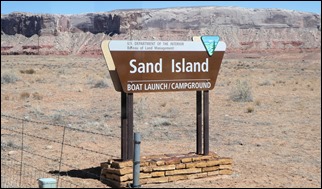
The huge Navajo reservation lay between us and Flagstaff, and there are few-to-no camping opportunities there. So we elected to spend one more night in Utah before going to Flagstaff. Pickings are slender down near the border, and we chose a nondescript camp called Sand Island, just outside of Bluff, UT.
We weren’t expecting much from the town of Bluff, but it’s actually kind of a charming little community with a great backdrop and some nice homes. It’s situated on the bank of the San Juan River, which is fronted by a long escarpment that gave the town its name.
If you happen to pass through Bluff, be sure to stop by the Twin Rocks trading post. They have a purely outstanding (and expensive) collection of Indian crafts, all 100% authentic and of the highest quality. Forget the junk Chinese import throwaway crap — this stuff is the real McCoy. In addition, the proprietor is a wise and kindly old codger who is a wealth of information on the town and the area.
After chatting with the Twin Rocks owner, we headed northeast up UT-261, for a look at the Moki Dugway.
This section of road is quite remarkable. The 65mph highway runs smack into a 2000-foot-high bluff and seems to disappear entirely. But it doesn’t. Instead, it turns into a wide, steep, twisty gravel road that somehow manages to scale the formidable cliff.
And of course, always with the ever-present range cattle. Short-horns in this instance.
It’s an awesome road, with awesome views. It can be a little scary, because there are no guardrails, and wandering off the edge would result in a guaranteed fatal plummet down the cliff. No texting, please. (There’s no cell coverage anyway.)
From the top of Moki Dugway, UT-261 resumes its docile, paved structure and courses on to the north. Also, off to the southwest, a short five-mile dirt track (Muley Point Road) weaves across the top of the plateau and ends at the Goosenecks overlook.
This is yet another stretch of the San Juan River, winding in strikingly serpentine fashion through deep canyons. This is just one bend of 10 major diversions, that swoop back and forth over about a 10-mile stretch of terrain. Sure would be a heck of a rafting trip.
The land at Muley Point is open and public, and we saw several folks camped there, some quite near the precipitous edge (maybe 30 feet from the drop). It would definitely be an impressive view to wake to in the morning (no sleepwalking). But oh well, we already had Howie ensconced at Sand Island, so we boogied back “home”.
An uneventful evening, and a warm morning followed. We drove southwest down US-163 so we could cast our eyes on Monument Valley and its iconic formations. But we didn’t pause — we were Expo bound.
STILL CURIOUS?
https://www.nps.gov/cany/planyourvisit/needles.htm
http://bluffutah.org/mokey-dugway-muley-point/
https://www.dangerousroads.org/north-america/usa/783-mokee-dugway-usa.html
https://utah.com/goosenecks-state-park
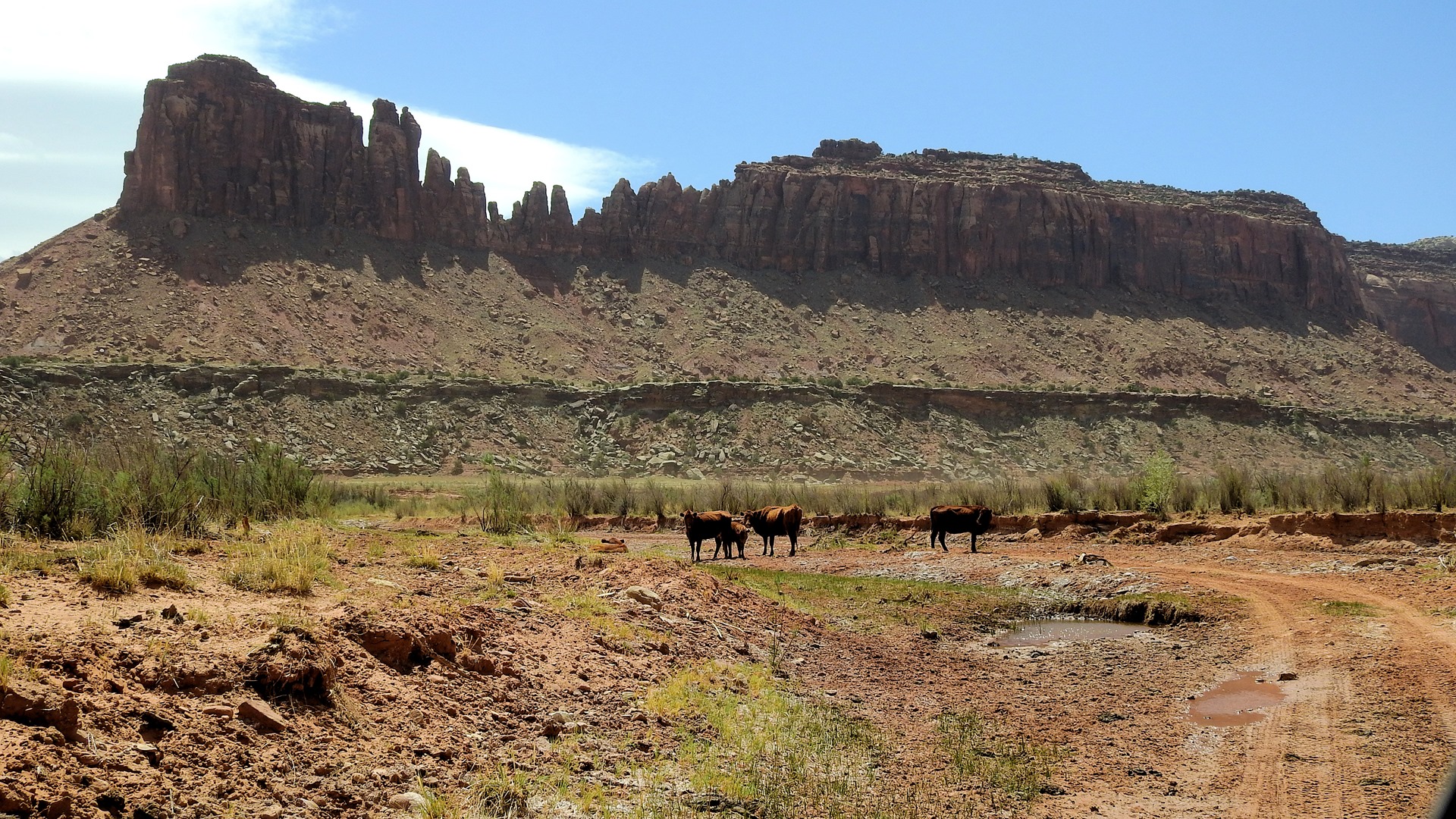
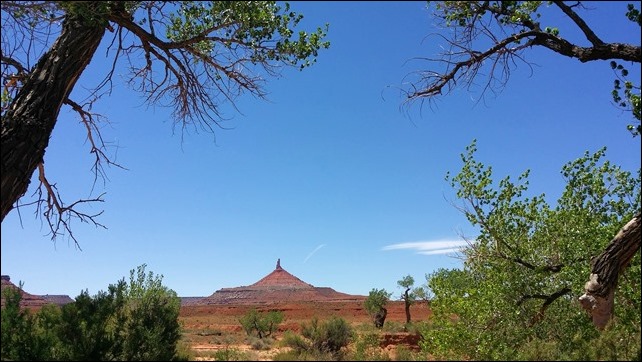
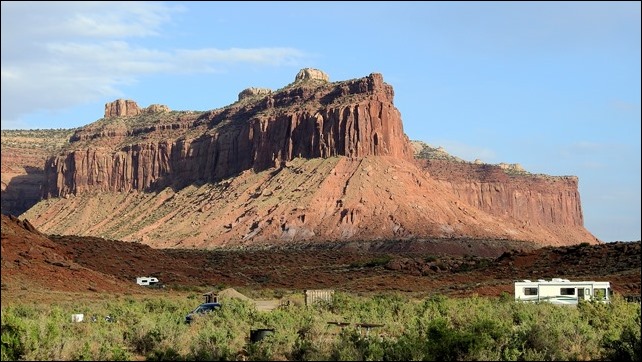
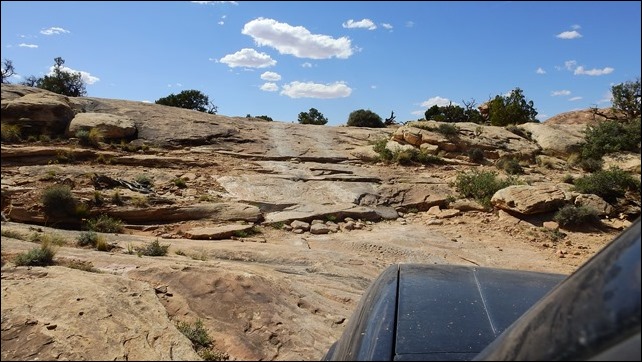
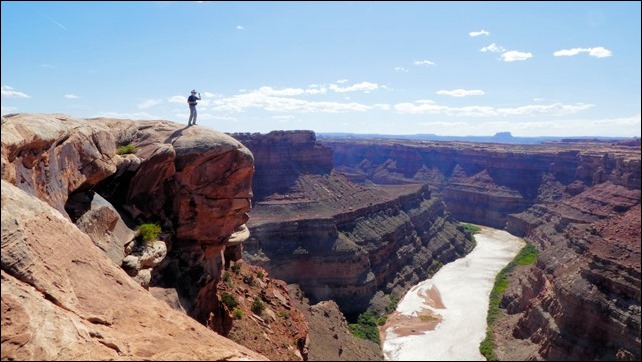
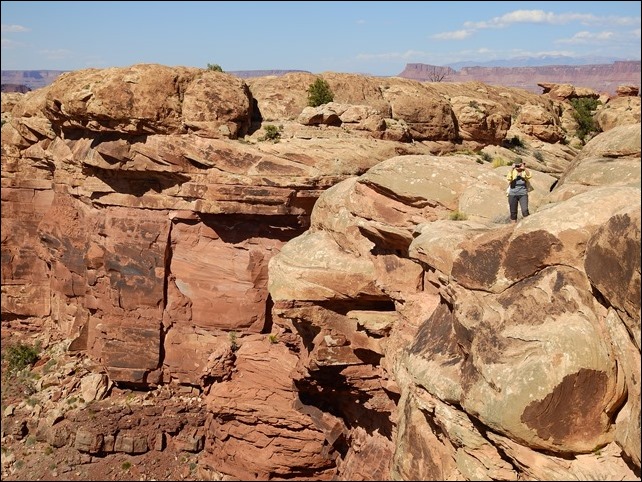
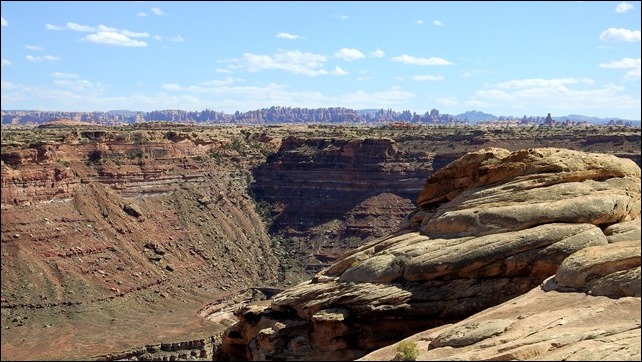
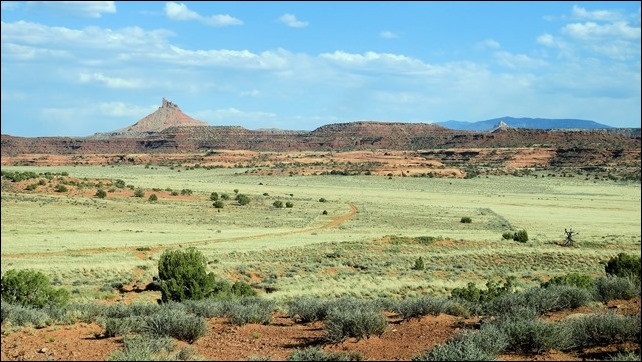
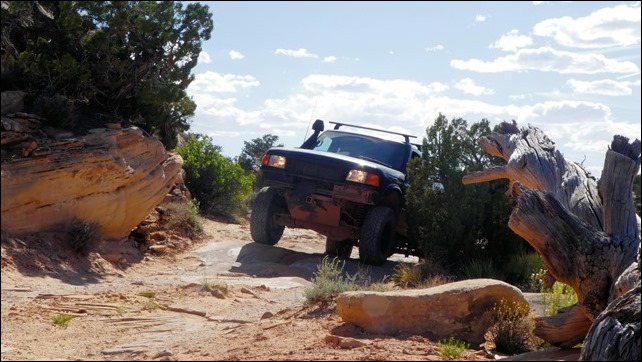
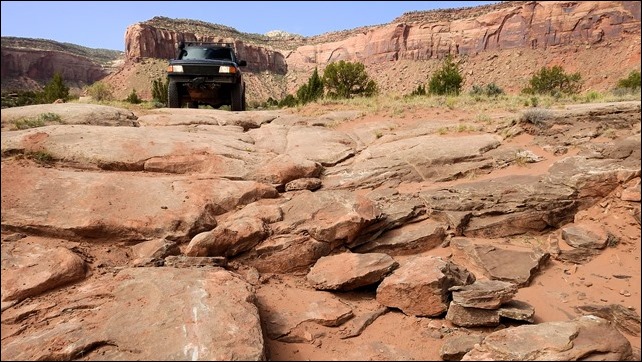
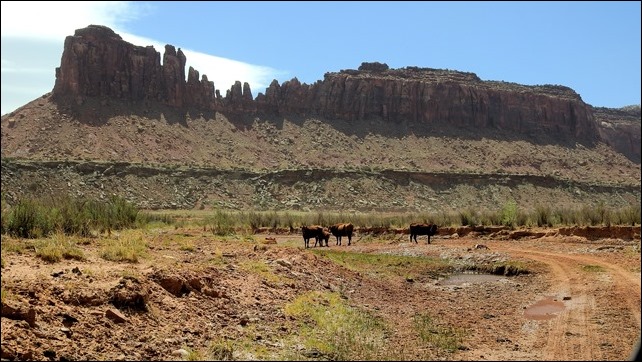
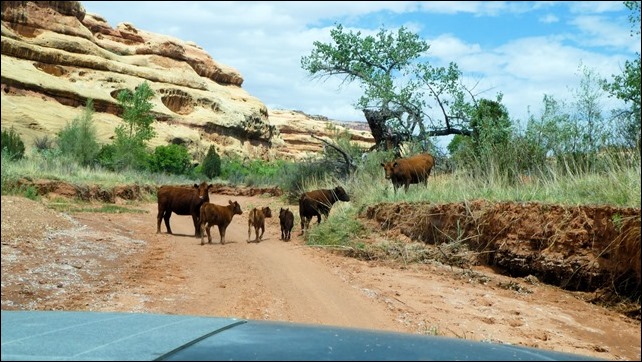
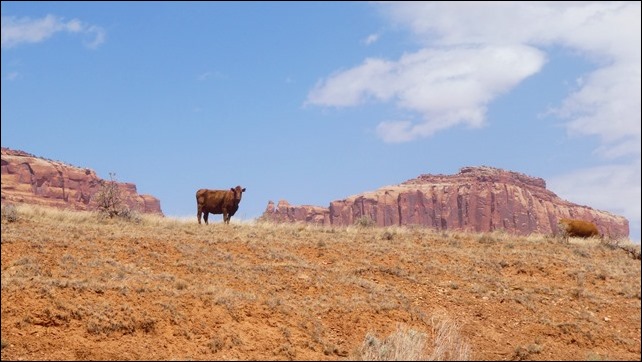
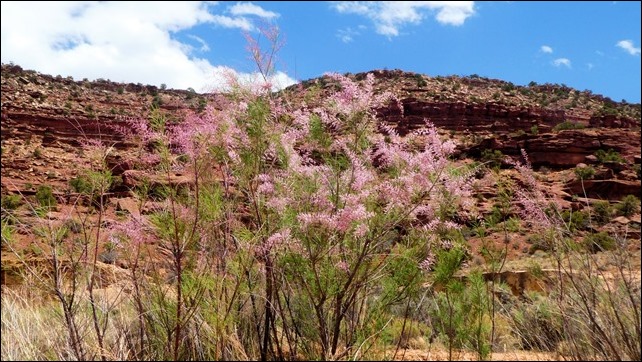
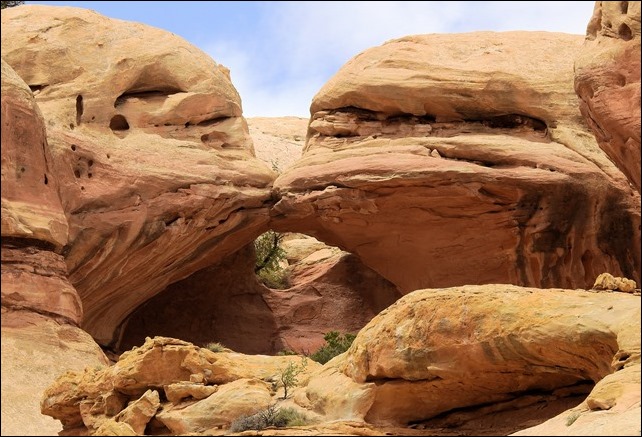
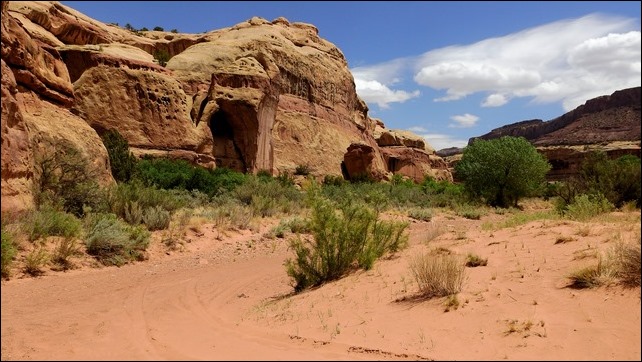
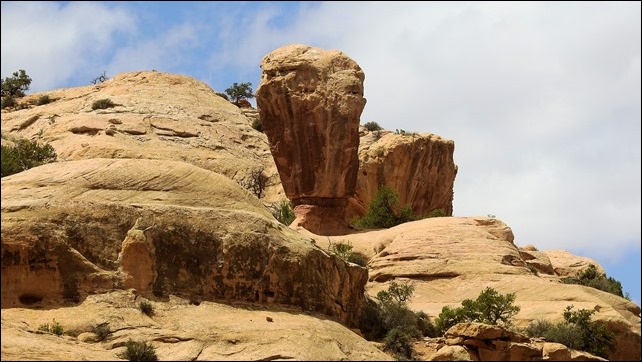
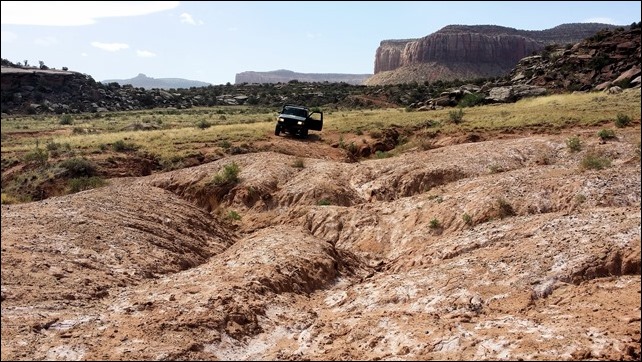
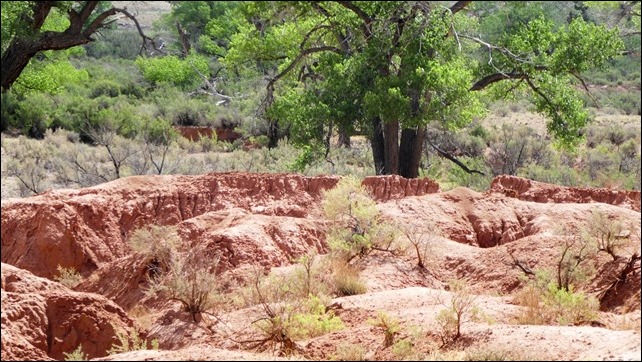
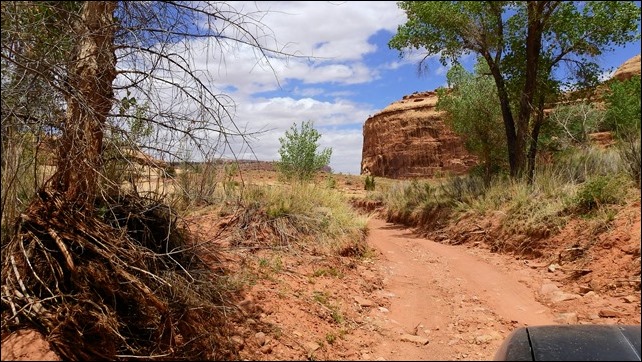
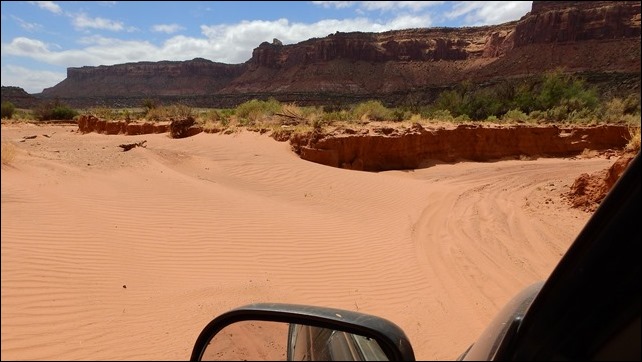
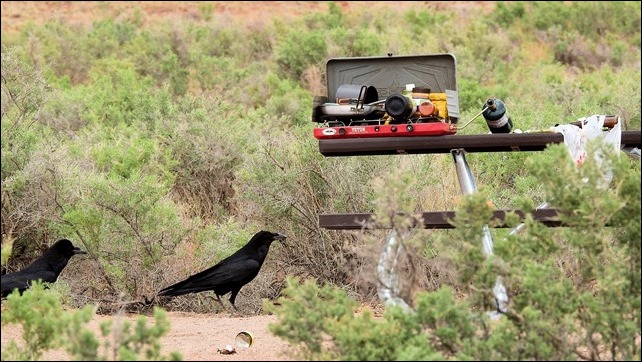
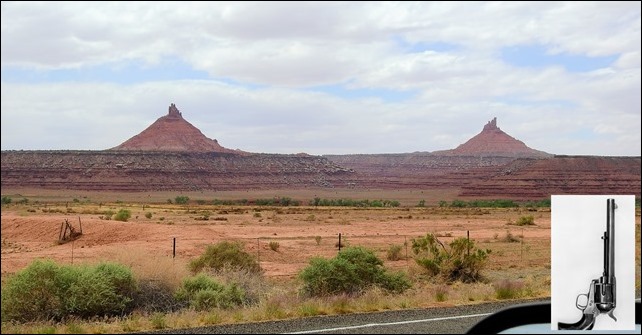
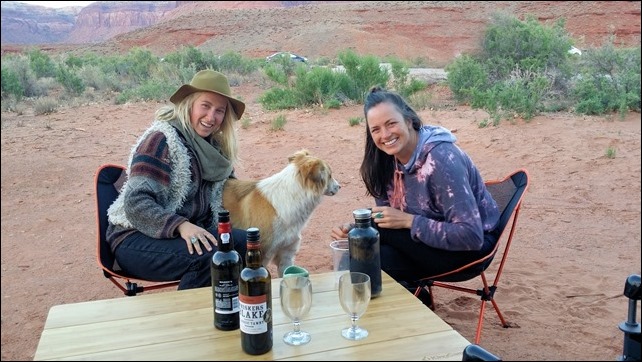
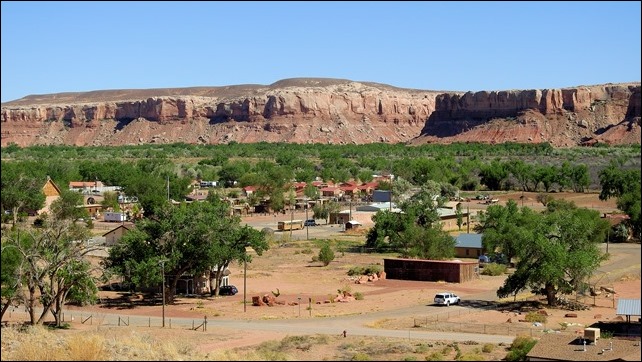
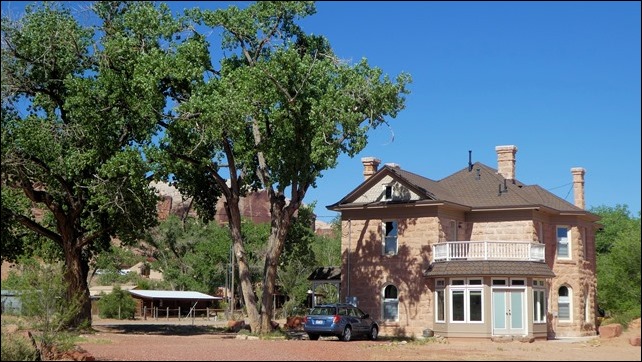
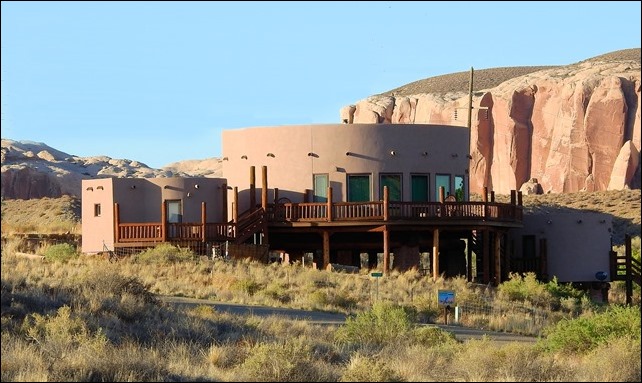
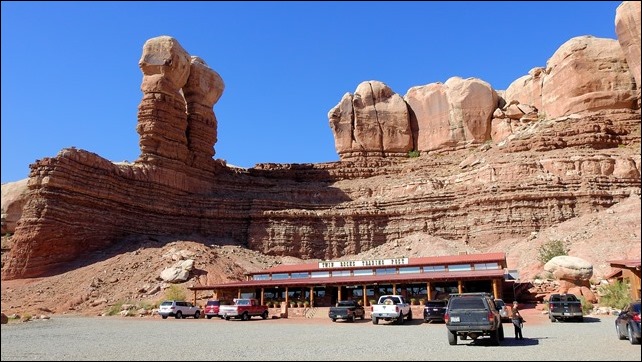
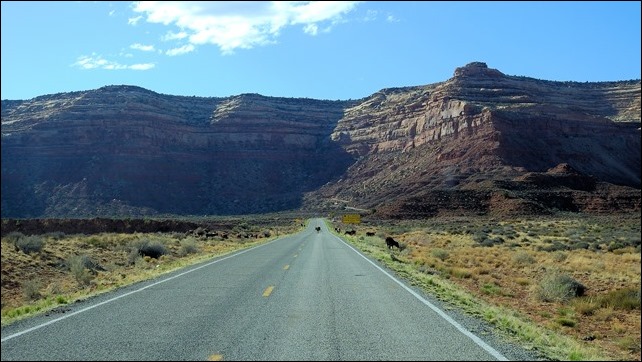
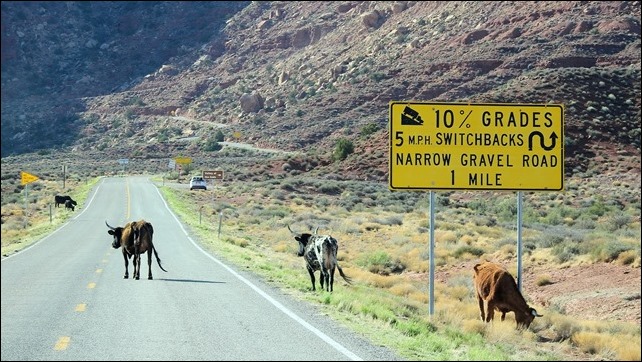
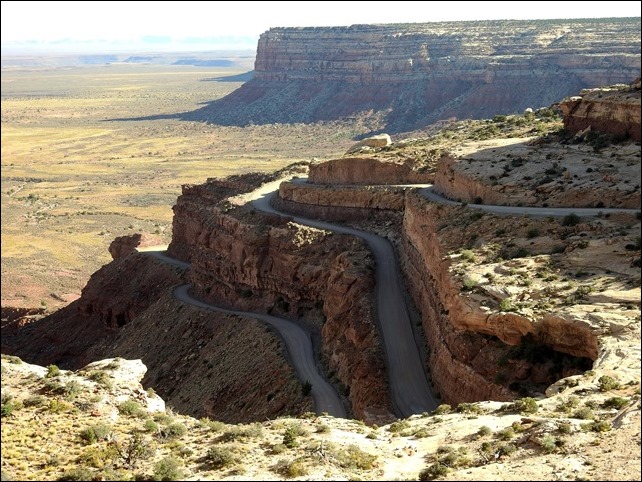
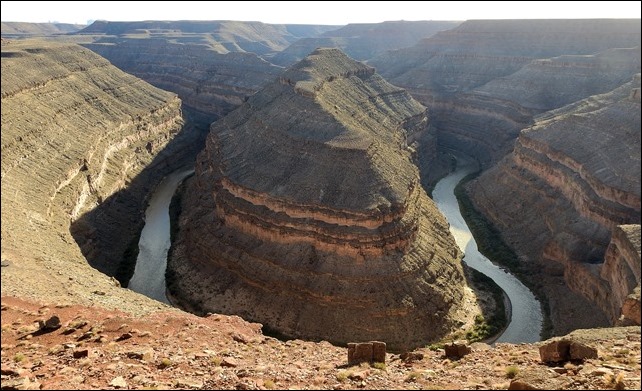
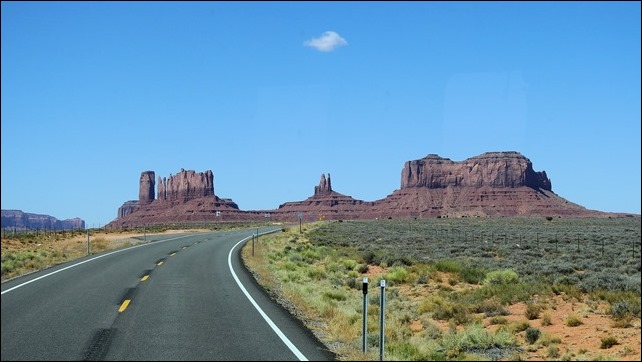
Hey Greg,
What are range cattle? Are they owned by anyone?
xo,
cousin Barb
Hey Barb,
Range cattle graze on open range, as opposed to pastures or feed lots. Open range can be private or (leased) public, and fenced along the highways or not. We’ve seen all of these varieties.
All cattle are owned by private ranchers, and raised for dairy or meat. Although we’ve seen lots of wild horses and wild burros, I do not believe there are any wild cattle. This is probably due to the fact that they are very heavy and slow (easy to kill), and have had their survival instincts bred out of them over centuries of domestic herding. They can tolerate wild country and hard weather, but are easy prey for coyotes and mountain lions.
The ranchers typically have some of their own private land, and they pay the BLM (Bureau of Land Management) grazing fees per head of cattle for additional land. The fees vary widely depending on the land. Out in Nevada and Utah, grazing land can be so poor as to require 100 acres per head for viability.
I haven’t yet figured out what determines whether to fence land or not. I’ve seen desolate land in the middle of nowhere with fencing, and much more populated areas with no fencing. Cattle density also varies, so that’s not it either.
And it’s not at all predictable. Once, out in Utah, we pulled onto the empty highway, sped up to 65, came around a bend and then had to slow to a crawl for sheep and cattle that were drinking rain water out of the puddles in the (non-fenced) road.
Hi,Greg & Karen, Thanks for another great series of photos of one of our favourite areas of USA. Interesting that you are headed to Sth Africa soon. We are doing a House Exchange to Namibia in December! We kayaked down the Zambezi, and to say it as incredible, and scarey as all hell, would be putting it mildly! Have a great trip.
Elizabeth and John,
We’ve long known that it’s near-impossible for us to go anywhere that you haven’t been…. :o)
But with Ralph’s narrow stance and high clearance, we have been able to get to some “snug” remote places.
Kayaking on the Zambezi, dang. Fortunately (for us wimps), Mana Pools is flat-water, with big guided canoes. Just steer clear of the hippos and crocs.
G.
Greg, we are lusting too! Been more than a few years since we’ve been to SE Utah. You bring back memories for us. Maybe you should do that rafting trip. It would be an interesting post I’m sure and even more interesting (and exciting) for you two to experience. Thanks!
Dennis and Linda,
Well, we don’t be rafting, but about a month from now we are going to be canoeing near the Zambezi River in southern Africa. We’ll be taking a two-day safari in a place called Mana Pools. Should be fun, y’think? Howie and Ralph, sadly, cannot join us, but we’ll be fine… :o)
G.
Greg, Your descriptions are well done. You share the pleasures of exploring and discovering in a way that makes the reader lust after doing the same. (At least it works for me!). Thanks
for taking the time to let us in on these experiences.
Kendall and Judy,
It’s always great to share, and it’s especially nice when great compliments come with it.
Thanks for reading, and you have my permission to follow your lusts. :o)
G.